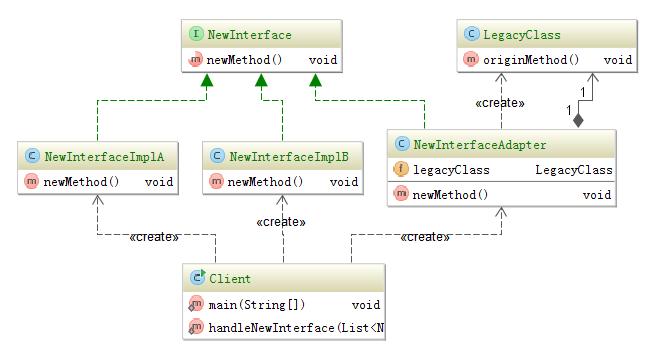Java adapter pattern example 2016-12-27 03:39
Let's say you have an interface named "NewInterface"; you have two classes which implement the interface. Client will loop the list of NewInterface. The code of client is like following.
public class Client {
public static void main(String[] args) {
List<NewInterface> newInterfaces = new ArrayList<>();
newInterfaces.add(new NewInterfaceImplA());
newInterfaces.add(new NewInterfaceImplB());
handleNewInterface(newInterfaces);
}
private static void handleNewInterface(List<NewInterface> newInterfaceList){
for (NewInterface impl : newInterfaceList) {
impl.newMethod();
}
}
}
The interface and implementation are like following.
public interface NewInterface {
void newMethod();
}
public class NewInterfaceImplA implements NewInterface {
@Override
public void newMethod() {
System.out.println("this is implementA of new method");
}
}
public class NewInterfaceImplB implements NewInterface {
@Override
public void newMethod() {
System.out.println("this is implementB of new method");
}
}
Let's say now you want reuse LagacyClass; the code of it is like following.
public class LegacyClass {
public void originMethod(){
System.out.println("this is original method");
}
}
You can't pass the instance of LegacyClass into handleNewInterface method; because it is not an implementation of NewInterface. In this case we can use "Adapter pattern". Create an Adapter which named NewInterfaceAdapter; the code of it is like following.
public class NewInterfaceAdapter implements NewInterface {
private LegacyClass legacyClass = new LegacyClass();
@Override
public void newMethod() {
legacyClass.originMethod();
}
}
After creating NewInterfaceAdapter you can change the code of client like following.
public class Client {
public static void main(String[] args) {
List<NewInterface> newInterfaces = new ArrayList<>();
newInterfaces.add(new NewInterfaceImplA());
newInterfaces.add(new NewInterfaceImplB());
newInterfaces.add(new NewInterfaceAdapter());//new adapter and handle it as an implementation of NewInterface
handleNewInterface(newInterfaces);
}
private static void handleNewInterface(List<NewInterface> newInterfaceList){
for (NewInterface impl : newInterfaceList) {
impl.newMethod();
}
}
}
The output is like following.
this is implementA of new method
this is implementB of new method
this is original method
